Deck 23: Operational Decision-Making Tools: Linear Programming
Question
Question
Question
Question
Question
Question
Question
Question
Question
Question
Question
Question
Question
Question
Question
Question
Question
Question
Question
Question
Question
Question
Question
Question
Question
Question
Question
Question
Question
Question
Question
Question
Question
Question
Question
Question
Question
Question
Question
Question
Question
Question
Question
Question
Question
Question
Question
Question
Question
Question
Question
Question
Question
Question
Question
Question
Question
Question
Question
Question
Question
Question
Question
Question
Question
Question
Question
Question
Question
Question
Question
Question
Question
Question
Question
Question
Question
Question
Question
Question

Unlock Deck
Sign up to unlock the cards in this deck!
Unlock Deck
Unlock Deck
1/92
Play
Full screen (f)
Deck 23: Operational Decision-Making Tools: Linear Programming
1
One objective of material requirements planning (MRP) is to utilize all available capacity.
False
2
Because the item master file is an input into the MRP process, it should be routinely updated to reflect any revisions or changes.
True
3
A matrix is used to organize and display the information generated by the MRP process.
True
4
Modular bills of material are used to group small, lose parts together into a kit.

Unlock Deck
Unlock for access to all 92 flashcards in this deck.
Unlock Deck
k this deck
5
Lot sizing rules are used in MRP to determine work or purchase order quantities.

Unlock Deck
Unlock for access to all 92 flashcards in this deck.
Unlock Deck
k this deck
6
A forecast of dependent demand requirements is one of the major inputs into the MRP process.

Unlock Deck
Unlock for access to all 92 flashcards in this deck.
Unlock Deck
k this deck
7
The periodic order quantity (POQ) lot sizing technique places orders every demand period.

Unlock Deck
Unlock for access to all 92 flashcards in this deck.
Unlock Deck
k this deck
8
Information concerning on-hand quantities, lot sizes, and lead time can be found in the master production schedule (MPS).

Unlock Deck
Unlock for access to all 92 flashcards in this deck.
Unlock Deck
k this deck
9
Effective capacity is determined by multiplying the rated capacity by utilization and efficiency.

Unlock Deck
Unlock for access to all 92 flashcards in this deck.
Unlock Deck
k this deck
10
Firms that successfully implement an MRP system no longer require cycle counting of inventory.

Unlock Deck
Unlock for access to all 92 flashcards in this deck.
Unlock Deck
k this deck
11
Gross requirements at one level of a product structure generate gross requirements at the next level.

Unlock Deck
Unlock for access to all 92 flashcards in this deck.
Unlock Deck
k this deck
12
A material requirements planning (MRP) system serves as both an inventory control system and as a production scheduling system.

Unlock Deck
Unlock for access to all 92 flashcards in this deck.
Unlock Deck
k this deck
13
The quantities displayed on a master production schedule represent production and not actual demand.

Unlock Deck
Unlock for access to all 92 flashcards in this deck.
Unlock Deck
k this deck
14
The total length of time required to manufacture a product is called its cumulative lead time.

Unlock Deck
Unlock for access to all 92 flashcards in this deck.
Unlock Deck
k this deck
15
Material requirements planning (MRP) translates the master production schedule into requirements for components, subassemblies, and raw materials.

Unlock Deck
Unlock for access to all 92 flashcards in this deck.
Unlock Deck
k this deck
16
Complex products typically do not require material requirements planning (MRP) to plan production or monitor inventory levels.

Unlock Deck
Unlock for access to all 92 flashcards in this deck.
Unlock Deck
k this deck
17
The master production schedule (MPS) is a major input for the MRP process.

Unlock Deck
Unlock for access to all 92 flashcards in this deck.
Unlock Deck
k this deck
18
A phantom bill of material is appropriate when a product consists of assemblies that are later combined to form a variety of final products.

Unlock Deck
Unlock for access to all 92 flashcards in this deck.
Unlock Deck
k this deck
19
The quantities reported on a master production schedule may reflect a combination of actual and forecasted demand.

Unlock Deck
Unlock for access to all 92 flashcards in this deck.
Unlock Deck
k this deck
20
Material requirements planning (MRP) is useful for managing and scheduling discrete demand items.

Unlock Deck
Unlock for access to all 92 flashcards in this deck.
Unlock Deck
k this deck
21
Customer relationship management (CRM) software plans and executes business processes that involve customer interactions.

Unlock Deck
Unlock for access to all 92 flashcards in this deck.
Unlock Deck
k this deck
22
A load profile displays underloads and overloads.

Unlock Deck
Unlock for access to all 92 flashcards in this deck.
Unlock Deck
k this deck
23
The application modules that comprise the ERP system are designed to support only customer relationship management processes.

Unlock Deck
Unlock for access to all 92 flashcards in this deck.
Unlock Deck
k this deck
24
Capacity requirements planning (CRP) projects the load from a given material plan onto the capacity of a system.

Unlock Deck
Unlock for access to all 92 flashcards in this deck.
Unlock Deck
k this deck
25
Single-source ERP systems are often easier to integrate than systems built using the best-in-breed approach.

Unlock Deck
Unlock for access to all 92 flashcards in this deck.
Unlock Deck
k this deck
26
ERP application modules can be used alone or in combination.

Unlock Deck
Unlock for access to all 92 flashcards in this deck.
Unlock Deck
k this deck
27
Cloud computing involves on-demand IT services.

Unlock Deck
Unlock for access to all 92 flashcards in this deck.
Unlock Deck
k this deck
28
Capacity requirement planning (CRP) converts the material plan into labor and machine workloads.

Unlock Deck
Unlock for access to all 92 flashcards in this deck.
Unlock Deck
k this deck
29
A _______________ of material is used to plan the production of products with many optional features.
A) K-bill
B) modular bill
C) phantom bill
D) time-phased bill
A) K-bill
B) modular bill
C) phantom bill
D) time-phased bill

Unlock Deck
Unlock for access to all 92 flashcards in this deck.
Unlock Deck
k this deck
30
The last stage in ERP implementation involves analyzing business processes.

Unlock Deck
Unlock for access to all 92 flashcards in this deck.
Unlock Deck
k this deck
31
All of the following are inputs into the MRP process except
A) the master production schedule.
B) the product structure file.
C) the item master file.
D) the planned order report.
A) the master production schedule.
B) the product structure file.
C) the item master file.
D) the planned order report.

Unlock Deck
Unlock for access to all 92 flashcards in this deck.
Unlock Deck
k this deck
32
Supply chain management (SCM) software plans and executes business processes related to a manufacturing firm.

Unlock Deck
Unlock for access to all 92 flashcards in this deck.
Unlock Deck
k this deck
33
The item master file contains all the following except
A) on-hand quantities.
B) lead times.
C) planned order releases.
D) on-order quantities.
A) on-hand quantities.
B) lead times.
C) planned order releases.
D) on-order quantities.

Unlock Deck
Unlock for access to all 92 flashcards in this deck.
Unlock Deck
k this deck
34
A phantom bill of material is used
A) to group small, loose parts together.
B) when the product is manufactured in major subassemblies.
C) for subassemblies that are immediately consumed in the next stage of production.
D) when due dates have not been calculated.
A) to group small, loose parts together.
B) when the product is manufactured in major subassemblies.
C) for subassemblies that are immediately consumed in the next stage of production.
D) when due dates have not been calculated.

Unlock Deck
Unlock for access to all 92 flashcards in this deck.
Unlock Deck
k this deck
35
Load leveling is used to resolve underloaded and overloaded capacity conditions.

Unlock Deck
Unlock for access to all 92 flashcards in this deck.
Unlock Deck
k this deck
36
Customer relationship management systems change the focus from managing products to managing customers.

Unlock Deck
Unlock for access to all 92 flashcards in this deck.
Unlock Deck
k this deck
37
ERP is beneficial because it transforms transactional data into information that can be used to support decision making.

Unlock Deck
Unlock for access to all 92 flashcards in this deck.
Unlock Deck
k this deck
38
Material requirements planning (MRP) is a useful for all of the following except
A) dependent demand items.
B) discrete demand items.
C) independent demand items.
D) erratic orders.
A) dependent demand items.
B) discrete demand items.
C) independent demand items.
D) erratic orders.

Unlock Deck
Unlock for access to all 92 flashcards in this deck.
Unlock Deck
k this deck
39
The product structure file provides all of the following information except
A) the product's demand.
B) the items that go into the product.
C) a brief description of each item.
D) when and in what quantity each item is needed in the assembly process.
A) the product's demand.
B) the items that go into the product.
C) a brief description of each item.
D) when and in what quantity each item is needed in the assembly process.

Unlock Deck
Unlock for access to all 92 flashcards in this deck.
Unlock Deck
k this deck
40
An enterprise resource planning (ERP) system shares information across functional areas.

Unlock Deck
Unlock for access to all 92 flashcards in this deck.
Unlock Deck
k this deck
41
The MRP process of subtracting on-hand quantities and scheduled receipts from gross requirements to produce net requirements is referred to as
A) cycle counting.
B) lot sizing.
C) exploding.
D) netting.
A) cycle counting.
B) lot sizing.
C) exploding.
D) netting.

Unlock Deck
Unlock for access to all 92 flashcards in this deck.
Unlock Deck
k this deck
42
Given the following MRP matrix for Item E:  The projected on hand quantity at the end of period 3 is
The projected on hand quantity at the end of period 3 is
A) 0.
B) 100.
C) 300.
D) 500.
 The projected on hand quantity at the end of period 3 is
The projected on hand quantity at the end of period 3 isA) 0.
B) 100.
C) 300.
D) 500.

Unlock Deck
Unlock for access to all 92 flashcards in this deck.
Unlock Deck
k this deck
43
The MRP process of determining requirements for lower level items based on the master production schedule is referred to as
A) lot sizing.
B) netting.
C) backward scheduling.
D) exploding.
A) lot sizing.
B) netting.
C) backward scheduling.
D) exploding.

Unlock Deck
Unlock for access to all 92 flashcards in this deck.
Unlock Deck
k this deck
44
Given the following Product Structure Record  The number of D's required for each A is
The number of D's required for each A is
A) 2.
B) 3.
C) 6.
D) 12.
 The number of D's required for each A is
The number of D's required for each A isA) 2.
B) 3.
C) 6.
D) 12.

Unlock Deck
Unlock for access to all 92 flashcards in this deck.
Unlock Deck
k this deck
45
Given the following MRP matrix for Item E:  The planned order releases for period 3 is
The planned order releases for period 3 is
A) 300.
B) 200.
C) 75.
D) 0.
 The planned order releases for period 3 is
The planned order releases for period 3 isA) 300.
B) 200.
C) 75.
D) 0.

Unlock Deck
Unlock for access to all 92 flashcards in this deck.
Unlock Deck
k this deck
46
Given the following MRP matrix for Item C:  If each order cost $500 and the holding cost is $0.75 per item per period, then using the Periodic Order Quantity lot sizing technique, the planned order release for period 1 is
If each order cost $500 and the holding cost is $0.75 per item per period, then using the Periodic Order Quantity lot sizing technique, the planned order release for period 1 is
A) 270.
B) 290.
C) 340.
D) 560.
 If each order cost $500 and the holding cost is $0.75 per item per period, then using the Periodic Order Quantity lot sizing technique, the planned order release for period 1 is
If each order cost $500 and the holding cost is $0.75 per item per period, then using the Periodic Order Quantity lot sizing technique, the planned order release for period 1 isA) 270.
B) 290.
C) 340.
D) 560.

Unlock Deck
Unlock for access to all 92 flashcards in this deck.
Unlock Deck
k this deck
47
Given the following MRP matrix for Item C:  If each order cost $500 and the holding cost is $0.75 per item per period, then using the Periodic Order Quantity lot sizing technique, the planned order release for period 4 is
If each order cost $500 and the holding cost is $0.75 per item per period, then using the Periodic Order Quantity lot sizing technique, the planned order release for period 4 is
A) 270.
B) 290.
C) 340.
D) 560.
 If each order cost $500 and the holding cost is $0.75 per item per period, then using the Periodic Order Quantity lot sizing technique, the planned order release for period 4 is
If each order cost $500 and the holding cost is $0.75 per item per period, then using the Periodic Order Quantity lot sizing technique, the planned order release for period 4 isA) 270.
B) 290.
C) 340.
D) 560.

Unlock Deck
Unlock for access to all 92 flashcards in this deck.
Unlock Deck
k this deck
48
Given the following Product Structure Record 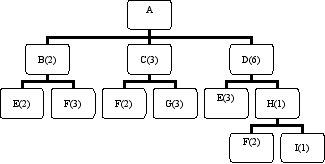 The number of F's required for each A is
The number of F's required for each A is
A) 6.
B) 12.
C) 18.
D) 24.
 The number of F's required for each A is
The number of F's required for each A isA) 6.
B) 12.
C) 18.
D) 24.

Unlock Deck
Unlock for access to all 92 flashcards in this deck.
Unlock Deck
k this deck
49
Given the following MRP matrix for Item D:  The planned order release for period 5 is
The planned order release for period 5 is
A) 100.
B) 120.
C) 160.
D) 270.
 The planned order release for period 5 is
The planned order release for period 5 isA) 100.
B) 120.
C) 160.
D) 270.

Unlock Deck
Unlock for access to all 92 flashcards in this deck.
Unlock Deck
k this deck
50
Given the following Product Structure Record 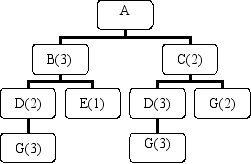 The number of G's required for each A is
The number of G's required for each A is
A) 40.
B) 20.
C) 18.
D) 3.
 The number of G's required for each A is
The number of G's required for each A isA) 40.
B) 20.
C) 18.
D) 3.

Unlock Deck
Unlock for access to all 92 flashcards in this deck.
Unlock Deck
k this deck
51
Given the following MRP matrix for Item E:  The planned order releases for period 1 is
The planned order releases for period 1 is
A) 300.
B) 200.
C) 75.
D) 0.
 The planned order releases for period 1 is
The planned order releases for period 1 isA) 300.
B) 200.
C) 75.
D) 0.

Unlock Deck
Unlock for access to all 92 flashcards in this deck.
Unlock Deck
k this deck
52
Given the following MRP matrix for Item D:  The projected on hand quantity at the end of period 3 is
The projected on hand quantity at the end of period 3 is
A) 0.
B) 20.
C) 60.
D) 70.
 The projected on hand quantity at the end of period 3 is
The projected on hand quantity at the end of period 3 isA) 0.
B) 20.
C) 60.
D) 70.

Unlock Deck
Unlock for access to all 92 flashcards in this deck.
Unlock Deck
k this deck
53
Given the following MRP matrix for Item D:  The planned order receipt for period 6 is
The planned order receipt for period 6 is
A) 100.
B) 120.
C) 160.
D) 270.
 The planned order receipt for period 6 is
The planned order receipt for period 6 isA) 100.
B) 120.
C) 160.
D) 270.

Unlock Deck
Unlock for access to all 92 flashcards in this deck.
Unlock Deck
k this deck
54
Given the following Product Structure Record 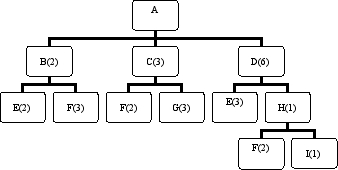 The number of I's required for each A is
The number of I's required for each A is
A) 1.
B) 2.
C) 6.
D) 12.
 The number of I's required for each A is
The number of I's required for each A isA) 1.
B) 2.
C) 6.
D) 12.

Unlock Deck
Unlock for access to all 92 flashcards in this deck.
Unlock Deck
k this deck
55
Given the following Product Structure Record 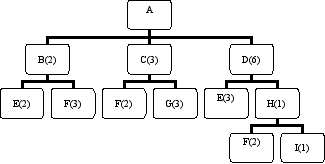 The number of G's required to assemble 10 A's is
The number of G's required to assemble 10 A's is
A) 9.
B) 10.
C) 90.
D) 180.
 The number of G's required to assemble 10 A's is
The number of G's required to assemble 10 A's isA) 9.
B) 10.
C) 90.
D) 180.

Unlock Deck
Unlock for access to all 92 flashcards in this deck.
Unlock Deck
k this deck
56
Given the following MRP matrix for Item C:  If each order cost $500 and the holding cost is $0.75 per item per period, then using the Periodic Order Quantity lot sizing technique, the projected on hand at the end of period 7 is
If each order cost $500 and the holding cost is $0.75 per item per period, then using the Periodic Order Quantity lot sizing technique, the projected on hand at the end of period 7 is
A) 330.
B) 270.
C) 0.
D) 140.
 If each order cost $500 and the holding cost is $0.75 per item per period, then using the Periodic Order Quantity lot sizing technique, the projected on hand at the end of period 7 is
If each order cost $500 and the holding cost is $0.75 per item per period, then using the Periodic Order Quantity lot sizing technique, the projected on hand at the end of period 7 isA) 330.
B) 270.
C) 0.
D) 140.

Unlock Deck
Unlock for access to all 92 flashcards in this deck.
Unlock Deck
k this deck
57
______________ is a lot sizing technique that orders for multiple demand periods is referred to as
A) Lot-for-lot (L4L)
B) Periodic order quantity (POQ)
C) Economic order quantity(EOQ)
D) Multiple order quantity (MOQ)
A) Lot-for-lot (L4L)
B) Periodic order quantity (POQ)
C) Economic order quantity(EOQ)
D) Multiple order quantity (MOQ)

Unlock Deck
Unlock for access to all 92 flashcards in this deck.
Unlock Deck
k this deck
58
Given the following MRP matrix for Item D:  The planned order release for period 3 is
The planned order release for period 3 is
A) 100.
B) 160.
C) 270.
D) 300.
 The planned order release for period 3 is
The planned order release for period 3 isA) 100.
B) 160.
C) 270.
D) 300.

Unlock Deck
Unlock for access to all 92 flashcards in this deck.
Unlock Deck
k this deck
59
Given the following MRP matrix for Item C:  If each order cost $500 and the holding cost is $0.75 per item per period, the periodic order quantity is
If each order cost $500 and the holding cost is $0.75 per item per period, the periodic order quantity is
A) 3 periods of requirements
B) 2 periods of requirements
C) 1 period of requirements
D) 0 period of requirements
 If each order cost $500 and the holding cost is $0.75 per item per period, the periodic order quantity is
If each order cost $500 and the holding cost is $0.75 per item per period, the periodic order quantity isA) 3 periods of requirements
B) 2 periods of requirements
C) 1 period of requirements
D) 0 period of requirements

Unlock Deck
Unlock for access to all 92 flashcards in this deck.
Unlock Deck
k this deck
60
Given the following Product Structure Record 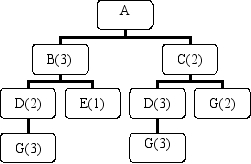 The number of E's required for each A is
The number of E's required for each A is
A) 1.
B) 2.
C) 3.
D) 4.
 The number of E's required for each A is
The number of E's required for each A isA) 1.
B) 2.
C) 3.
D) 4.

Unlock Deck
Unlock for access to all 92 flashcards in this deck.
Unlock Deck
k this deck
61
A firm has the following gross requirements for Item F. If ordering costs are $60 per order and carrying costs are $0.50 per period.  If EOQ lot sizing is used to set the minimum order quantity, then the projected on hand quantity at the end of period 3 is
If EOQ lot sizing is used to set the minimum order quantity, then the projected on hand quantity at the end of period 3 is
A) 40.
B) 0.
C) 100.
D) 20.
 If EOQ lot sizing is used to set the minimum order quantity, then the projected on hand quantity at the end of period 3 is
If EOQ lot sizing is used to set the minimum order quantity, then the projected on hand quantity at the end of period 3 isA) 40.
B) 0.
C) 100.
D) 20.

Unlock Deck
Unlock for access to all 92 flashcards in this deck.
Unlock Deck
k this deck
62
Which of the following would not be used for an overloaded condition?
A) pulling work ahead
B) rerouting jobs to alternative work centers
C) pushing work back
D) splitting lots between two or more machines
A) pulling work ahead
B) rerouting jobs to alternative work centers
C) pushing work back
D) splitting lots between two or more machines

Unlock Deck
Unlock for access to all 92 flashcards in this deck.
Unlock Deck
k this deck
63
Given the following Product Structure Record 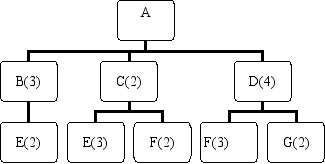 The number of F's required for each A is
The number of F's required for each A is
A) 2.
B) 3.
C) 12.
D) 16.
 The number of F's required for each A is
The number of F's required for each A isA) 2.
B) 3.
C) 12.
D) 16.

Unlock Deck
Unlock for access to all 92 flashcards in this deck.
Unlock Deck
k this deck
64
_____________________ is a software that organizes and manages a firms business processes by sharing information across functional areas.
A) Materials requirement planning (MRP)
B) Enterprise requirements planning (ERP)
C) Product lifecycle management (PLM)
D) None of these answer choices is correct.
A) Materials requirement planning (MRP)
B) Enterprise requirements planning (ERP)
C) Product lifecycle management (PLM)
D) None of these answer choices is correct.

Unlock Deck
Unlock for access to all 92 flashcards in this deck.
Unlock Deck
k this deck
65
A firm has the following gross requirements for Item F. If ordering costs are $60 per order and carrying costs are $0.50 per period.  If EOQ lot sizing is used the minimum order quantity is
If EOQ lot sizing is used the minimum order quantity is
A) 85
B) 100
C) 120
D) 150
 If EOQ lot sizing is used the minimum order quantity is
If EOQ lot sizing is used the minimum order quantity isA) 85
B) 100
C) 120
D) 150

Unlock Deck
Unlock for access to all 92 flashcards in this deck.
Unlock Deck
k this deck
66
Given the following Product Structure Record 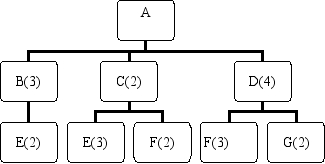 The number of E's required for each A is
The number of E's required for each A is
A) 3.
B) 6.
C) 12.
D) 24.
 The number of E's required for each A is
The number of E's required for each A isA) 3.
B) 6.
C) 12.
D) 24.

Unlock Deck
Unlock for access to all 92 flashcards in this deck.
Unlock Deck
k this deck
67
In ERP systems, advanced analytical capabilities that support decision making collectively is called business
A) intelligence.
B) support systems.
C) decision protocol.
D) None of these answer choices is correct.
A) intelligence.
B) support systems.
C) decision protocol.
D) None of these answer choices is correct.

Unlock Deck
Unlock for access to all 92 flashcards in this deck.
Unlock Deck
k this deck
68
_______________________ software plans and executes business processes involving customer interaction.
A) Product lifecycle management
B) Customer relationship management
C) Supply chain management
D) ERP
A) Product lifecycle management
B) Customer relationship management
C) Supply chain management
D) ERP

Unlock Deck
Unlock for access to all 92 flashcards in this deck.
Unlock Deck
k this deck
69
Given the following MRP matrix for Item E:  The planned order releases for period 4 is
The planned order releases for period 4 is
A) 300.
B) 200.
C) 75.
D) 0.
 The planned order releases for period 4 is
The planned order releases for period 4 isA) 300.
B) 200.
C) 75.
D) 0.

Unlock Deck
Unlock for access to all 92 flashcards in this deck.
Unlock Deck
k this deck
70
A firm has the following gross requirements for Item F. If ordering costs are $60 per order and carrying costs are $0.50 per period.  If EOQ lot sizing is used to set the minimum order quantity, then the planned order releases is
If EOQ lot sizing is used to set the minimum order quantity, then the planned order releases is
A) 40 in period 1 and 0 in period 3
B) 0 in period 2 and 80 in period 3
C) 120 in period 2 and 120 in period 3
D) 100 in period 2 and 100 in period 3
 If EOQ lot sizing is used to set the minimum order quantity, then the planned order releases is
If EOQ lot sizing is used to set the minimum order quantity, then the planned order releases isA) 40 in period 1 and 0 in period 3
B) 0 in period 2 and 80 in period 3
C) 120 in period 2 and 120 in period 3
D) 100 in period 2 and 100 in period 3

Unlock Deck
Unlock for access to all 92 flashcards in this deck.
Unlock Deck
k this deck
71
______________ refers to the selection of ERP modules from different vendors.
A) Integrated systems
B) Best-of-breed
C) Purchase optimization
D) None of these answer choices is correct.
A) Integrated systems
B) Best-of-breed
C) Purchase optimization
D) None of these answer choices is correct.

Unlock Deck
Unlock for access to all 92 flashcards in this deck.
Unlock Deck
k this deck
72
A load profile compares
A) requirements for all lower-level items to higher-level items.
B) cumulative lead times to projected lead times.
C) the quantities in which items should be produced to actual demand.
D) released and planned orders with work center capacity.
A) requirements for all lower-level items to higher-level items.
B) cumulative lead times to projected lead times.
C) the quantities in which items should be produced to actual demand.
D) released and planned orders with work center capacity.

Unlock Deck
Unlock for access to all 92 flashcards in this deck.
Unlock Deck
k this deck
73
ERP systems consist of a series of __________________ that can be used alone or in concert.
A) accounting applications
B) application modules
C) personal computers
D) None of these answer choices is correct.
A) accounting applications
B) application modules
C) personal computers
D) None of these answer choices is correct.

Unlock Deck
Unlock for access to all 92 flashcards in this deck.
Unlock Deck
k this deck
74
A firm has the following gross requirements for Item F. If ordering costs are $60 per order and carrying costs are $0.50 per period.  If L4L ordering is used the planned order releases is
If L4L ordering is used the planned order releases is
A) 40 in period 1 and 0 in period 3
B) 80 in period 2 and 60 in period 3
C) 60 in period 2 and 80 in period 3
D) 0 in period 1 and 40 in period 3
 If L4L ordering is used the planned order releases is
If L4L ordering is used the planned order releases isA) 40 in period 1 and 0 in period 3
B) 80 in period 2 and 60 in period 3
C) 60 in period 2 and 80 in period 3
D) 0 in period 1 and 40 in period 3

Unlock Deck
Unlock for access to all 92 flashcards in this deck.
Unlock Deck
k this deck
75
All of the following can be used for underloaded conditions except
A) acquiring additional work.
B) pushing work back.
C) pulling work ahead.
D) reducing normal capacity.
A) acquiring additional work.
B) pushing work back.
C) pulling work ahead.
D) reducing normal capacity.

Unlock Deck
Unlock for access to all 92 flashcards in this deck.
Unlock Deck
k this deck
76
A firm has the following gross requirements for Item F. If ordering costs are $60 per order and carrying costs are $0.50 per period.  If the periodic order quantity lot sizing rule is used, then planned order releases in Period 2 is
If the periodic order quantity lot sizing rule is used, then planned order releases in Period 2 is
A) 40 in period 1.
B) 60 in period 2.
C) 120 in period 3.
D) 140 in Period 2.
 If the periodic order quantity lot sizing rule is used, then planned order releases in Period 2 is
If the periodic order quantity lot sizing rule is used, then planned order releases in Period 2 isA) 40 in period 1.
B) 60 in period 2.
C) 120 in period 3.
D) 140 in Period 2.

Unlock Deck
Unlock for access to all 92 flashcards in this deck.
Unlock Deck
k this deck
77
Which of the following is not a major input into capacity requirements planning (CRP)?
A) planned order releases
B) routing file
C) load profiles for each work center
D) open orders file
A) planned order releases
B) routing file
C) load profiles for each work center
D) open orders file

Unlock Deck
Unlock for access to all 92 flashcards in this deck.
Unlock Deck
k this deck
78
Which one of the following is not one of the four main categories of ERP modules?
A) Finance/Accounting
B) Sales/Marketing
C) Human Resources
D) Information Technology
A) Finance/Accounting
B) Sales/Marketing
C) Human Resources
D) Information Technology

Unlock Deck
Unlock for access to all 92 flashcards in this deck.
Unlock Deck
k this deck
79
Given the following Product Structure Record 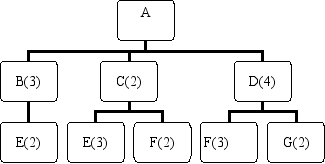 The number of G's required for each A is
The number of G's required for each A is
A) 2.
B) 8.
C) 12.
D) 24.
 The number of G's required for each A is
The number of G's required for each A isA) 2.
B) 8.
C) 12.
D) 24.

Unlock Deck
Unlock for access to all 92 flashcards in this deck.
Unlock Deck
k this deck
80
A firm has the following gross requirements for Item F. If ordering costs are $60 per order and carrying costs are $0.50 per period.  If the periodic order quantity lot sizing rule is used, the number of period's worth of requirements is
If the periodic order quantity lot sizing rule is used, the number of period's worth of requirements is
A) 0.
B) 1.
C) 2.
D) 3.
 If the periodic order quantity lot sizing rule is used, the number of period's worth of requirements is
If the periodic order quantity lot sizing rule is used, the number of period's worth of requirements isA) 0.
B) 1.
C) 2.
D) 3.

Unlock Deck
Unlock for access to all 92 flashcards in this deck.
Unlock Deck
k this deck



